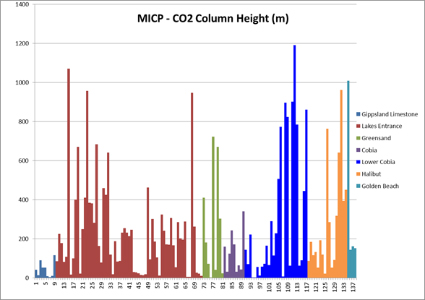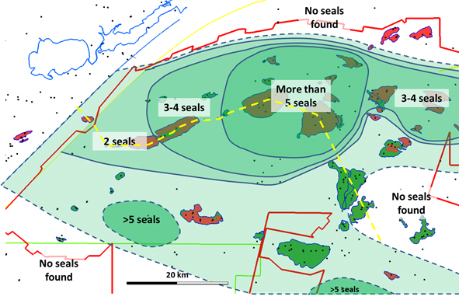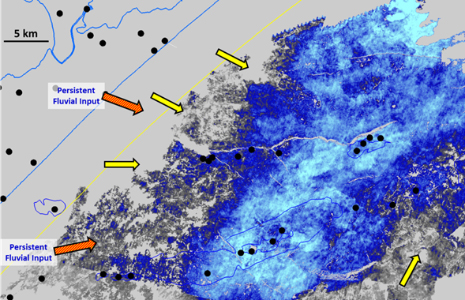Insights and Commentaries
Seals of the CarbonNet Project, Gippsland Basin, Victoria, Australia
15th October 2015
Topic(s): Carbon capture, CO2 storage, use and storage (CCUS)
The CarbonNet Project (the Project) has identified a series of prospective carbon dioxide (CO2) storage sites in the most promising area of the nearshore Gippsland Basin in south eastern Australia. The Project is investigating the potential for establishing a large–scale carbon capture and storage (CCS) hub with multiple industrial sources of CO2 in the nearby Latrobe Valley, transport via a shared pipeline and storage in deep saline formations. The development of the CO2 storage sites are the focus of a series of reports on the CarbonNet Project which have previously detailed the projects historical background, process for developing a commercial framework for a CCS hub network, geological characterisation and site selection process, and well integrity. The focus of the latest report is 3D mapping and correlation of intraformational seals within the Latrobe Group in the nearshore Gippsland Basin. In this Insight the Institute's Senior Adviser for Storage (Asia Pacific), Chris Consoli, discusses this critical aspect of the site characterisation and development of the CarbonNet Project.
CO2 storage fundamentals
Around the world there are a vast number of potential sites for storing CO2 underground. Identifying and characterising these sites in a timely manner will be essential if we are to deploy carbon capture and storage (CCS) projects at a scale necessary to tackle climate change.
Oil and gas accumulations are an indicator of the appropriate geology for a CO2 storage site. The geological formations that store oil and gas do so in a similar manner to CO2. Gas and liquids are stored in the microscopic pores - spaces between the grains of permeable rock formations - under high pressure. When these formations are covered with an impermeable seal or 'caprock' the accumulating liquid is trapped for geological timescales of millions of years. Such trapped oil and gas can be accessed for energy, and the same geological formations can be used for storing CO2.
To ensure there is sufficient capacity within a storage site, it is essential to perform rigorous feasibility studies including site assessment. These processes take time, so for CCS to play a role in cutting CO2 emissions to achieve global climate targets, there is a pressing need to identify and assess a large number of high quality storage sites, which calls for efficient search strategies.
The first step in assessing the feasibility of a CCS project is to identify and assess a geological basin as being suitable for storage and then to identify regions within that basin that are most suitable for early development of storage. Within this high-graded basin area, a suite of potential storage sites should be evaluated for their ability to safely store sufficient volumes of CO2 over geological time. This is known as the storage site characterisation phase. During the characterisation phase of a CO2 storage complex three key geological factors are assessed:
- Capacity – sufficient space in the reservoir(s) to accommodate the expected volume of CO2.
- Injectivity – characteristics to allow a sufficient rate of CO2 to be injected into the reservoir.
- Containment – an effective barrier to stop the leakage of injected CO2 from the reservoir(s).
Often the reservoir's capacity and injectivity are the major focus of characterisation studies, but all three need to be evaluated. Indeed, proving the containment of the CO2 plume is the single biggest hurdle in terms of stakeholder assurance and ultimately approval of the project.
What makes a good seal rock?
A good seal (or caprock) must have the capacity and integrity to prevent the movement of CO2 beyond the storage complex and enable permanent storage in the reservoir below, often leading to dissolution and mineralisation of the trapped CO2 over time. The ability for a seal to retain CO2 is controlled by the lithology, geometry and spatial distribution of the pores in the rock. Seals are typically a mudstone, siltstone, salt or cemented carbonate rock and ideally lithologically uniform. Preferably the seal will also be thick vertically (>10 m) and extensive laterally over a regional-scale and not contain permeable faults that dissect the entire sealing unit.
The effectiveness of a seal can be measured in three main ways:
- Proven to retain an oil and/or gas column either locally or nearby;
- Well data records a difference in pressure and salinity on each side of the seal meaning there is no fluid movement across the seal; and
- Laboratory tests on cores from the seal measures a CO2 column height greater than the expected CO2 volume in the reservoir below. One measurement technique is known as Mercury Injection Capillary Pressure (MICP).
Seal Geology of the Nearshore Gippsland Basin
The CarbonNet Project is targeting a series of storage sites in the nearshore Gippsland Basin, each site contains variations in their storage concept including what reservoir and seal will be used to permanently store the CO2. Focussing on seals, the Lakes Entrance Formation is the regional seal that extends across much of the basin including covering the area of interest. It is an excellent, thick effective seal and has retained hydrocarbons below it for several tens of millions of years. This formation could provide a final barrier to all storage concepts for the CarbonNet Project, but it may never be needed. This is because below the regional seal are the intraformational seals of the Latrobe Group which have also trapped oil and gas for similar timescales. They are called intraformational, as the sealing rocks lie within the same unit, the Latrobe Group, as the targeted storage reservoirs.
Until this latest report the intraformational seals of the Latrobe Group were poorly published in the literature, yet some of them have retained oil and gas accumulations and therefore have proven retention capacity which is important for both CO2 storage and oil and gas exploration. In particular, this report focuses on the major T2 seal as one of the primary seals for some of the storage sites of the CarbonNet Project. The T2 seal is part of the Traralgon Formation – a rock unit that is contemporaneous with some of the coalfields of the Latrobe Valley area. In the offshore area it is a mudstone and coal unit, 50-70 metres thick and over 1000 square kilometres in area. The mudstone and coals which make up the T2 seal accumulated in extensive peat swamps and estuaries around 40 million years ago during a substantial greenhouse period of Earth's climate.
The intraformational T2 seal exhibits three key features showing that it is a suitable seal:
- It is the seal unit for several oil accumulations that have trapped oil for millions of years;
- Pressure and salinity is different in reservoirs above and below the seal; and
- MICP measurements from T2 rock samples demonstrate a CO2 column retention capacity in excess of 100 metres (Figure 1).
The T2 seal can now be recognised as a primary seal and it's potential to act as a CO2 seal quantified.
Figure 1: MICP measurements on rock samples from the T2 seal

MICP measurements on rock samples from sealing rocks of the nearshore Gippsland Basin. The regional seal, Lake Entrance is excellent with an average of 233 metres CO2 column retention capacity. The T2 seal is part of the Lower Cobia Subgroup and demonstrates a CO2 column retention capacity has an average of 330 metres. Source: CarbonNet Project.
3D Seismic Seal Mapping
A section of particular interest within the report includes results of detailed analysis of the seals, including T2, using 3D seismic well data over the nearshore region. This analysis was possible because this region has one of the most complete records of 3D seismic data in Australia and includes a large number of wells. The report presents seismic mapping of the seals to define their thickness, geometry and extent. From the mapping and well data, the authors found that over most of the area of interest, multiple, stacked seals were present - all of them proven effective sealing units which potentially means that in the nearshore Gippsland Basin you could have numerous individual reservoir-seal pairs for storage.
Figure 2: Map of the number of intraformational seals in the nearshore Gippsland Basin

Well and seismic data over the nearshore Gippsland Basin reveals a series of stacked intraformational seals in a number of areas which enhance CO2 trapping ability. Source: CarbonNet Project.
Also during the seismic mapping and well interpretation exercise, the authors could determine the quality of the seals and the depositional environment by comparing the shape and patterns of the mapped seal to modern day analogues. Areas where the seal was thickest, or thin/absent and where the quality of the seal is better or worse could determined. For example, distinct lineations attributed to river systems that flowed during the deposition of the seal tens of millions of years ago would likely have a high sand content (Figure 3). These could be avoided or integrated into a storage scenario. This is an example of how the geological evolution of a basin and the depositional history of the seals and reservoirs in a storage complex are an important factor in site assessments. The depositional environment will influence the viability and operation of a CO2 storage injection project and are therefore a critical component of the characterisation phase of any CCS project feasibility study.
Figure 3: Seismic mapping of a coal unit in the nearshore Gippsland Basin

Evidence of channels cutting through the coal unit are visible (arrows). Source: CarbonNet Project.
Conclusion
In summary, the authors have found that the CarbonNet storage concept of using the intraformational seal rock units as a primary storage barrier within the nearshore Gippsland Basin would enable the permanent storage of significant quantities of CO2. By identifying the T2 seal as an extensive and effective seal, as well as numerous other intraformational seals, this investigation has revealed there may be hundreds of gigatonnes of additional storage available and confirms that the Gippsland Basin is a world class storage site for CCS.